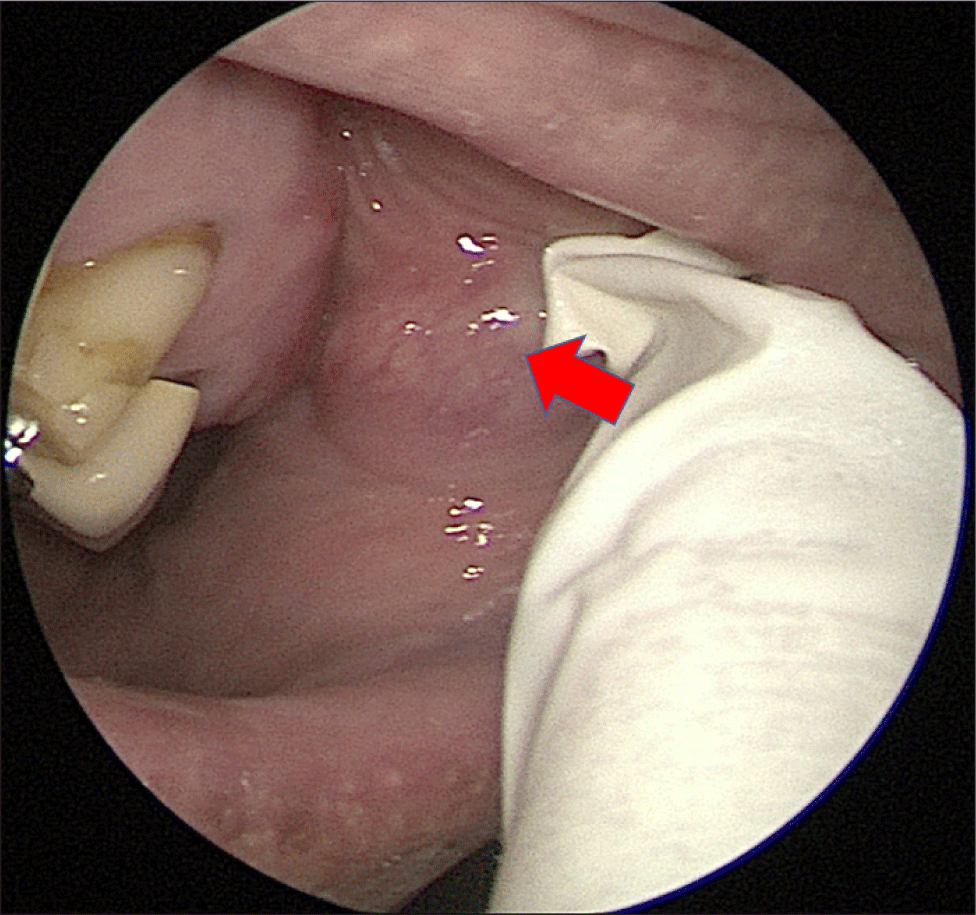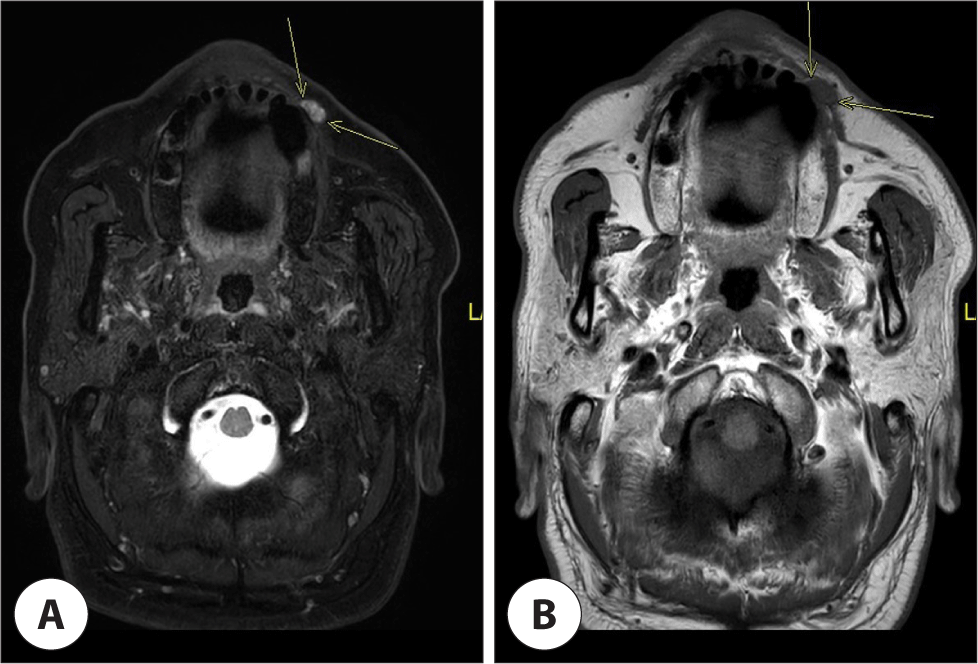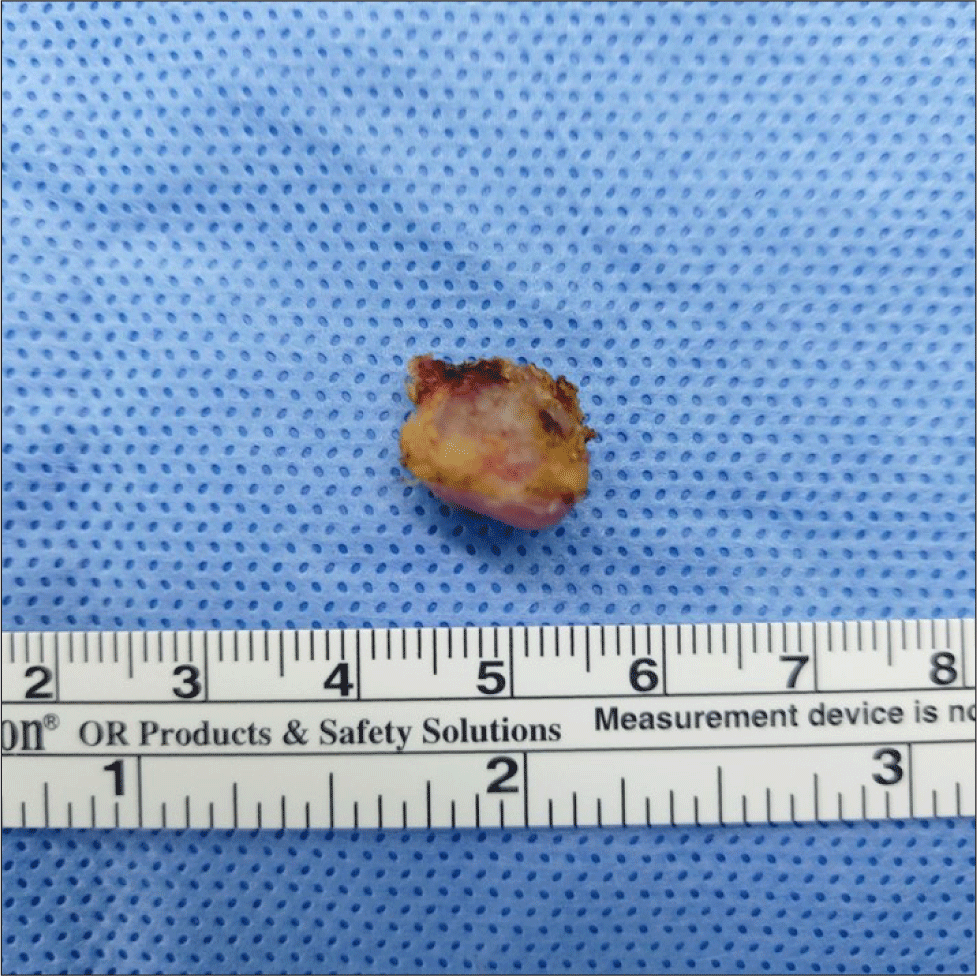서론
반전성 타액선관 유두종(inverted ductal papilloma)은 1982년에 White 등에 의해 처음 보고되었다.1) 반전성 타액선관 유두종은 매우 드문 양성 종양으로 소타액선의 침샘관으로부터 기인한다.2) 2017년 World Health Organization(WHO) 분류에서 타액선관 유두종(ductal papilloma)의 두 가지 이형을 타액선관 내 유두종(intraductal papilloma)과 반전성 타액선관 유두종으로 정리하였다.3) 반전성 타액선관 유두종의 드문 특성과 병리학적 명칭의 다양성 및 부정확성 때문에 정확한 유병률은 확인되지 않았다.4) 저자들은 국내에서 아직 보고되지 않은 구강내 반전성 타액선관 유두종 1예를 문헌 고찰과 함께 보고하고자 한다.
증례
76세 남자 환자가 우연히 발견된 좌측 윗입술 안쪽 점막에 만져지는 무통성종괴를 주소로 내원하였다. 이학적 소견으로는 해당 종괴는 대략 1 cm 정도로 촉지되었으며 점막하에 위치하였고 딱딱하고 둥근 형태였다(Fig. 1). 컴퓨터단층촬영(computed tomography, CT)에서는 치아에 의한 인공음영으로 병변이 확인되지 않아 자기공명영상(magnetic resonance image, MRI)을 추가로 시행하였다. 해당 병변은 좌측 윗입술에 경계가 잘 지어지고 소엽 모양의 결절성 병변으로 T2 영상에서 이질성 고강도, T1 영상에서 등강도의 음영을 보였다(Fig. 2). 소타액선 종양 의심하에 수술적 제거를 계획하였다. 원칙적으로 수술 전 세포학적 또는 조직학적 검사를 시행해야 하나 크기가 작아 절개 생검의 형태로 수술을 시행하였고, 조직검사 결과에 따라 추가 절제 가능성을 염두에 두고 수술을 계획하였다. 구강으로 접근하여 촉지되는 종괴는 구강 점막과 유착이 있어 바로 위의 점막을 포함하여 원형으로 절개를 가하고 해당 종괴를 박리하였다. 수술 과정에서 이하선관과는 연결성을 보이지 않았다. 구강 점막 외 주변 조직과의 유착은 없었으며 피막에 쌓여 있는 형태로 종괴는 완전히 제거할 수 있었다(Fig. 3). 조직병리학적 소견상 타액선관 내로 유두 돌출부를 보이는 잘 둘러싸인 관병변으로(Fig. 4A), 해당 유두 돌출부는 섬유혈관 중심부를 가진 증식성 편평세포의 분화를 보이며(Fig. 4B), 부분적으로 점액을 함유한 미세낭종을 관찰할 수 있었다(Fig. 4C). 종합적으로 판단했을 때 반전성 타액선관 유두종으로 진단하였고 해당 조직으로 인유두종 바이러스(human papillomavirus, HPV) 유전자형 검사를 시행하였을 때 고위험군 19종 및 저위험군 9종의 HPV에서 음성 소견을 확인할 수 있었다. 수술 후 1년간 외래 추적 관찰 결과 재발의 소견은 관찰되지 않았다.



고찰
반전성 타액선관 유두종은 White 등이 처음 해당 명칭을 소개하였고, 이는 비강 또는 방광에서 흔히 발생하는 반전성 유두종과 유사한 특징을 가지고 있었기 때문에 이렇게 명칭하였다.1) 통상적으로 중년 이상의 남성에서 좀 더 흔히 발생하는 것으로 알려져 있고 입술과 볼 점막이 흔한 발생 위치이다.2,4) 임상적으로 반전성 타액선관 유두종은 무증상의 경우가 많고, 점막하 결절의 형태로 나타나며, 직경이 1.5 cm 이상 넘는 경우는 흔하지 않다. 반전성 타액선관 유두종의 감별 진단으로 타액선관 내 유두종, 유두상 타액선종(sialadenoma papilliferum), 그리고 점액표피양암종(mucoepidermoid carcinoma) 등이 있다.5) 과거에는 타액선관 유두종의 이형으로 반전성 타액선관 유두종, 타액선관 내 유두종과 더불어 유두상 타액선종이 포함되어 있었으나, 2017년 WHO 분류에서 유두상 타액선종은 별도의 분류로 나뉘어졌고 타액선관 유두종에 반전성 타액선관 유두종과 타액선관 내 유두종만 남게 되었다.3) 형태학적으로 비부비동 반전성 유두종과 유사하지만 재발이나 악성 변형의 위험성은 없는 것으로 보고되었다.6) 매우 드문 질환으로 예후를 평가하기 어려우나 한 후향적 연구에서 13건의 반전성 타액선관 유두종 수술 후 재발을 없었음을 보고한 바 있다.7)
반전성 타액선관 유두종은 타액선 배출관과 점막 표피의 연결 부위에서 발생한다고 생각되고 있다. 그렇기 때문에 반전성 타액선관 유두종과 타액선관 내 유두종 모두 점막하 종양의 형태로 나타나지만 반전성 타액선관 유두종은 보다 타액선관의 말초부에, 타액선관 내 유두종은 근위부에 발생한다.7) 1984년에 주타액선관의 말초 부위에서 반전성 타액선관 유두종이 발생한 유일한 증례보고 외에는 거의 모든 증례에서 소타액선으로부터 기인하기 때문에 소타액선 종양으로 간주되고 있으며, 수술적 제거 과정에서 소타액선을 포함한 단순 절제로 충분한 경우가 많다.
반전성 타액선관 유두종의 표피 세포 성분은 타액선관 내 유두종과 구별되는 가장 중요한 특징이다. 타액선관 내 유두종은 잘 둘러싸인 단낭성 병변인 반면, 반전성 타액선관 유두종의 표피 세포 성분은 주변 결합조직으로 팽창하거나 밀어내는 특징이 있다. 이러한 특징 때문에 반전성 타액선관 유두종은 배설관 내에서 증식하여 점막 표면으로 병변이 열릴 수 있는 가능성이 있다. 타액선관 내 유두종과 비교하여 반전성 타액선관 유두종은 병리학적 차이뿐만 아니라 임상적으로 구강점막을 침범할 수 있고, 거의 모든 증례에서 소타액선 종양으로 나타난다는 차이점이 있다. 이러한 특성이 있기 때문에 수술적 제거를 고려할 때 종양 위 점막을 함께 제거해야 한다.7) 반전성 타액선관 유두종의 표피 세포 성분의 특징 때문에 점액표피양암종과의 구분이 중요하나 점액표피양암종처럼 다결절 또는 다낭성 영역을 보이지 않는다.2)
반전성 타액선관 유두종의 병태생리와 원인은 불분명하다. 몇몇 연구에서 반전성 타액선관 유두종과 HPV와의 관련성을 확인한 바 있다. 한 연구에서 6건의 반전성 타액선관 유두종 중 50%에서 제자리부합법(in situ hybridization) 검사상 HPV-6, 11 양성을 확인하였다.8) 하지만 다른 증례 보고들에서는 보다 정밀한 검사법을 시행하였을 때 HPV를 확인할 수 없었다고 보고하였다. 해당 증례 모두 점막에 입은 상해의 과거력이 있었고 점막 손상이 원인 요소로 추정되었다.9,10) 본 증례에서는 상해의 과거력은 확인할 수 없었으며 HPV 역시 확인할 수 없었다.
최근 연구에서 반전성 타액선관 유두종에서 HRAS 변이를 확인하였다. 양성 유두양 낭성 타액선관 종양들에서 BRAF, HRAS, AKT1 등의 변이들이 관찰됨으로써 mitogen-activated protein-kinase 유전자의 변이가 중요한 원인으로 추정되었다. 반면 비부비동 반전성 유두종의 악성 변형의 중요한 요소인 epidermal growth factor receptor 변이는 확인되지 않아 이러한 분자학적 차이로 인해 재발 및 악성 변형이 없는 얌전한 임상적 특징을 나타내게 된다.6) 그렇기 때문에 치료는 종양의 완전 절제로 충분한 경우가 많다.
반전성 타액선관 유두종은 소타액선에서 발생하는 드문 양성 종양으로 악성 변화를 거의 하지 않고 예후가 좋다. 하지만 소타액선에서 발생하는 침샘암, 특히 점액표피양암종과의 구분이 중요하여 조직학적 진단이 필수적이다. 대부분 구강 점막하 종양의 형태로 나타나지만 점막 표면과 종양이 가까워 구강 점막을 포함하여 제거해야 하기 때문에 수술 전 촉진을 통해 구강 점막과의 연관성을 확인해야 한다.







